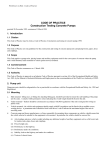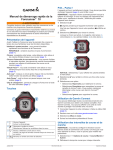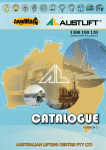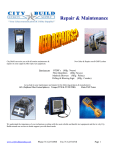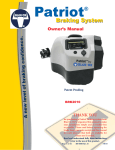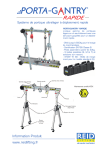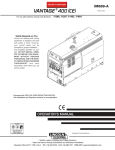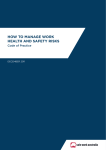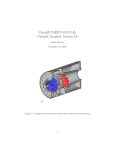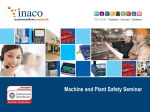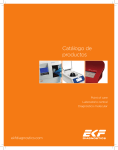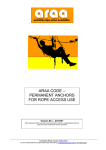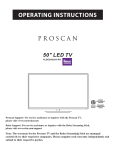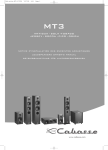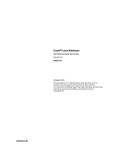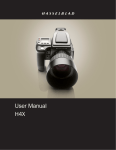Download Height Safety Essentials Booklet
Transcript
EVERY WORKER’S
GUIDE TO
HEIGHT
SAFETY
ESSENTIALS
DEVELOPED IN THE INTEREST OF WORKER SAFETY BY
THE FALL PROTECTION EXPERTS.
CONTENTS
This booklet is written as an introductory guide to height safety.
Use it when evaluating your fall protection requirements, however,
always consult a fall protection specialist if you’re unsure of any
aspect of fall protection or fall protection equipment.
The A, B, C, D of
Fall Protection
12 Fundamental Facts
Of Fall Protection
Fall Clearance &
Swing Fall Hazards
Inspection &
Maintenance
3
4
10
14
Training
18
Regulations &
Authorities
Glossary of Fall
Protection Terminology
20
24
Workplace Resources
30
THE A,B,C,D
OF FALL PROTECTION
The A,B,C,D of Fall Protection covers the fundamental
requirements of every personal fall protection system.
ANCHORAGE
Anchorage provides a secure point of attachment (to an
existing structure) for the fall arrest system. Anchorage
devices can be permanent or temporary and vary to suit the
type of structure available.
BODY SUPPORT
Full body harnesses connect the worker to the fall arrest
system. They are specially designed to protect the worker
against serious injury in the event of a fall whilst also
remaining comfortable to wear.
Connectors are devices that connect the full body harness
to the anchorage system. They can be single products or
multiple devices working together.
DESCENT/RESCUE
Descent & Rescue systems enable the retrieval of an injured or
incapacitated worker. In the event of a rescue, this equipment
facilitates rapid recovery of the worker without endangering
other workers in the process.
THE A,B,C,D OF FALL PROTECTION
CONNECTORS
3
12 FUNDAMENTAL
FACTS OF FALL
PROTECTION
1 Gravity never takes a rest
A person can always:
đƫƫ ((ƫ0$.+1#$ƫƫ#,ƫ+.ƫ3!'ƫ/1."!
đƫƫ ((ƫ+2!.ƫ*ƫ! #!Čƫ+.
đƫƫ .%,ƫ+.ƫ/(%,ƫ +3*ƫƫ/(+,!
Gravity is there waiting for your “bad day” when you have a
momentary “slip up”.
2 It is not the fall that causes
the death or injury
Injury is caused by the shock of suddenly stopping,
or hitting objects or the ground during the fall.
If there is any risk of a fall, consideration should be given to
clearance distances and the pendulum effect.
Australian and New Zealand Standards requires that when
using a fall arrest system, the maximum fall arrest force that a
person can be exposed to is 6kN (611kg).
3 Falls from height represent 16% of all
fatalities in the workplace in Australia*
đƫ 39% of these fatalities were in the construction industry
đƫ Most fatal falls are from roofs, scaffolding and ladders
*
4
Source: Safe work Australia - Notified Fatalities Statistical
Report 2009-2010.
4
Writing a fall protection plan helps prevent
fall-related injuries
An effective fall protection plan uses:
ƫ đƫƫ!2!(/ƫ+"ƫ+*0.+(ċƫ$%/ƫ%/ƫ((! ƫƫ$%!..$5ƫ+"ƫ+*0.+(ċƫ
It uses administrative (such as a “lock out” system)
and engineering control measures. These measures are
elimination, substitution, isolation and fall protection
ƫ đƫƫ6. ƫĒƫ%/'ƫ//!//)!*0ċƫ$%/ƫ%/ƫ0$!ƫ%*2!/0%#0%+*ƫ+"ƫ0$!ƫ
likelihood of an accident or injury occurring, versus the
severity of the injury
ƫ
đƫƫ$0ƫ%*/0.10%+*/ƫĨ%*(1 %*#ƫ.!/1!ĩƫ*!! ƫ0+ƫ!ƫ3.%00!*
ƫ
đƫ$0ƫ!-1%,)!*0ƫ*!! /ƫ0+ƫ!ƫ1/!
ƫ
đƫ$0ƫ0.%*%*#ƫ%/ƫ*!!//.5
The best type and combination of equipment that should be used can
be very specific to the actual height safety situation. AS/NZS 1891.4
gives guidance on equipment selection for the right situation.
Fall protection plans are similar to work method statements.
Work method statements should be clear, to the point and if
helpful, include sketches.
If in doubt ask! A competent person must perform the
risk assessment. You can become competent through a
combination of reading, comprehending, gaining practical
experience, observing and completing training. It’s the law!
See Fundamental Fact #12, on page 9.
12 FUNDAMENTAL FACTS OF FALL PROTECTION
ƫ 6. /ƫ*!! ƫ0+ƫ!ƫ% !*0%ü! Čƫ//!//! Čƫ!2(10! Čƫ0$!*ƫ
eliminated or controlled. Australian and New Zealand Standard
AS/NZS 4360 gives guidance on risk management. Risk
assessment and control measures help decide:
ƫ đƫƫ$0ƫ$6. /ƫ.!ƫ%*2+(2! ƫ3%0$ƫ0$!ƫ0/'ƫ* ƫ3$+ƫ+1( ƫ!ƫ
affected by the dangers
5
5
There is no such thing as a safe distance to
fall
The further you fall, the faster your speed of descent and
the higher the total forces that the safety system needs to
absorb to prevent injuries. The further you fall, the more
likely you are to hit the ground, or swing into a wall or hit
the nearest obstacle below you.
You should use work-in-restraint techniques to remove the
possibility of a fall, or to maintain a fall distance of less than
2 metres. You must never put yourself in a situation where
you can free fall more than two metres.
Refer to the Shock Absorbing Lanyard and Self Retracting
Lifeline Fall Clearance Calculations on pages 10 and 11.
6
You must be connected to a structure using
your safety system at all times
Using double-action or triple-action connectors on your
shock absorbing system helps prevent metal components
from disconnecting.
Unintentional disconnection of hardware by itself is called
forced rollout.
Do not disconnect from one safety system, unless you
have connected to another or are in a secure location.
7
The anchor/connection point you
connect to must be very strong
The anchorage you use must be capable of holding the
3!%#$0ƫ+"ƫƫ")%(5ƫ/%6! ƫ.ċƫ$%/ƫ%/ƫ!-1(ƫ0+ƫ0ƫ(!/0ƫāĆ'ƫ
ĨāČĆĀĀ'#ĩČƫ/ƫ.!-1%.! ƫ5ƫĥƬāĉĊāċąƫ"+.ƫƫ/%*#(!ƫ,!./+*ƫ
anchorage, or 21kN for a 2 person anchorage point. The
structure should be free from burrs and sharp edges that
might damage your equipment when in use.
6
8
A belt should never be used for fall arrest or
limited free fall
Belts are no longer recognised by Australian and New
Zealand Standards as a legitimate fall protection device.
A harness is better for any work situation where you can slip,
trip, slide or fall. A full body harness distributes the fall arrest
forces better around the body. A belt should never be used in
a fall arrest situation.
9
The harness must be fitted and
adjusted correctly
10
It is too late to plan a rescue after
somebody has fallen and they are
suspended in mid-air
The ability for a worker to hang in a fall arrest harness after
a fall is limited if they are unconscious. Most standards
worldwide recognise the need for a timely rescue within
āĆġăĀƫ)%*10!/ċƫ
An effective rescue plan will ensure that there are procedures
put into place to adopt in an emergency. Effective rescue can
be performed by fellow workers if they are well trained.
Safety first - do not put yourself at risk to save another person.
12 FUNDAMENTAL FACTS OF FALL PROTECTION
All safety equipment shall be used according to the instructions
supplied by the manufacturer. Correct fitting and adjustment better
distributes forces of a fall impact and lowers the risk of injury.
7
11
The inspection and maintenance
instructions of height safety systems and
equipment must be understood
and followed
Inspection frequency requirements must be followed
according to AS/NZS 1891.4 and the manufacturer’s user
instructions. All inspection and maintenance data must be
recorded in an inspection and maintenance log kept by the
company.
All fall protection equipment must be inspected prior to and
after each use by the user and periodically by a height safety
equipment inspector as defined by Australian Standard AS/
NZS 1891.4*. Australian and New Zealand Standards provide
guidelines for the frequency of inspection, as does local
OH&S legislation.
Australian and New Zealand Standards also require
that all fall arrest devices such as SRLs be subjected
to a full inspection and service by factory Accredited
Service Centres, or every 12 months in the absence of any
instructions/recommendations from the manufacturer.
They must also be re-certified by the manufacturer or their
accredited service agent after they have been used to arrest
a fall.
* Note: AS/NZS 1891.4 defines a competent person as:
A person who has, through a combination of training,
qualification and experience, acquired knowledge and skills
enabling that person to correctly perform a specified task.
Levels of competency are now defined in the informative
appendix in AS/NZS 1891.4, refer to the definitions in the
Glossary, on page 28.
8
12
You must be competently trained
If you are required to perform any tasks at height, you must be
competently trained as per AS/NZS 1891.4.
A successful fall protection training program should cover the
following:
ƫ
đƫ!-1%.!)!*0/ƫ+"ƫ/0* . /ƫ* ƫ(!#%/(0%+*
ƫ
đƫ !*0%ü0%+*ƫ+"ƫ.!(0%2!ƫ$6. /
ƫ
đƫƫ,,(%0%+*ƫ+"ƫ0$!ƫ$%!..$5ƫ+"ƫ+*0.+(ƫ* ƫ+0$!.ƫ)!/1.!/ƫ
to minimise and control risk
ƫ
đƫ!/1!ƫ,(*/ƫ* ƫ,.+! 1.!/
ƫ
đƫƫ$!ƫ1/!Čƫü0Čƫ%*/,!0%+*ƫ* ƫ)%*0!**!ƫ+"ƫ"((ƫ,.+0!0%+*ƫ
equipment
All employers and employees have a duty of care to maintain a
safe working environment.
+.'!./ƫ)1/0ƫ!ƫ+),!0!*0(5ƫ0.%*! ƫ0+ƫ% !*0%"5ƫ0$!ƫ$6. /ƫ
and when required, use fall protection equipment and systems
safely, to reduce or eliminate the risk of injury.
This guide is not a substitute for
competent training. Capital Safety offers a range
of internationally accepted courses nationally recognised
under VETAB, refer to page 18 for more information.
12 FUNDAMENTAL FACTS OF FALL PROTECTION
When selecting your training provider, ensure they are
a Registered Training Organisation (RTO) certified and
accredited under the AQTF. This is an indicator that the
organisation is a credible training provider that meets
nationally recognised standards. Also, choose a course
that carries a competency relevant to the work tasks being
completed.
9
FALL CLEARANCE &
SWING FALL HAZARDS
SHOCK ABSORBING
LANYARD
FALL CLEARANCE
CALCULATION
RD =
Required Distance Below Working
Surface to Nearest Obstruction
Working
Surface
FFD = Free Fall Distance
(2.0m maximum allowed)
DD =
C=
Energy Absorber
Deceleration Distance
When using a DBI-SALA lanyard
ĨāċĈĆ)ƫ"+.ƫ1/!./ƫ1,ƫ0+ƫāăć'#ĩƫ
ĨāċĊĆ)ƫ"+.ƫ1/!./ƫ".+)ƫāăć'#ƫ
to 160kg)
+ D-ring Slide and Harness
0.!0$ƫĨĀċĂĆ)ĩƫ
RD
Clearance to Obstruction
During Fall Arrest
(1.0m minimum safety factor
required)
FFD +
DD +
C
RD
FFD
DD
As per AS/NZS 1891.4,
DD can be estimated based
upon FFD in order to reduce RD.
10
Nearest
Obstruction
C
FFD
Extension
600 mm
1000 mm
āĆĀĀƫ))
2000 mm
300 mm
ĆĀĀƫ))
600 mm
900 mm
Fall clearance is the vertical distance needed to safely arrest a
fall so that the worker does not hit the ground. To determine
the required Fall Clearance add the appropriate factors
together, this will give you the safe Required Distance (RD)
below the working surface for work which is to be carried out
where there is any risk of falling.
SELF RETRACTING
LIFELINE
FALL CLEARANCE
CALCULATION
RD =
Required Distance Below
Working Surface to
Working
Surface
Nearest Obstruction
DD =
Free Fall, Lock Off and
Deceleration (1.4m
.*!//ƫ0.!0$ƫĨĀċĂĆ)ĩ
C=
Clearance to Obstruction
RD
During Fall Arrest
(1.0m minimum safety
factor required)
DD +
C
RD
DD
C
Nearest
Obstruction
As per AS/NZS 1891.4,
DD can be estimated at
700mm. 250mm must be
added for D-ring slide.
FALL CLEARANCE & SWING FALL HAZARDS
Max.) + D-ring Slide and
11
SWING FALL HAZARDS
Swing Fall can occur when using a shock absorbing lanyard or
self retracing lifeline (SRL) whilst working at height.
A swing fall is a pendulum-like motion that can occur when the
operator falls and their connector device is in a position located
$+.%6+*0((5ƫ35ƫ".+)ƫ0$!ƫ*$+.#!ƫ,+%*0ċƫ$%/ƫ%/ƫ)+/0ƫ(%'!(5ƫ
to occur when connected to an anchorage point that is not
positioned directly overhead.
.!10%+*/ƫ0+ƫ2+% ƫ0$%/ƫ$6. ƫ%*(1 !ƫ.!)+2%*#ƫ3+.'%*#ƫ
slack from the rope working line, using restraint techniques and
ensuring the person does not approach a leading edge such that
they may be subjected to an unplanned fall.
Operators should ensure they do not subject themselves to
swing fall by taking measures to avoid the risk. Refer to Figure
*!ƫ* ƫ3+ƫ"+.ƫ!4),(!/ƫ+"ƫ/3%*#ƫ"((ƫ$6. /ċƫ
FIGURE ONE: swing fall as a result of incorrect
anchorage line positioning.
12
Note: It is important to position your anchor point
%.!0(5ƫ+2!.$! ƫ0+ƫ)%*%)%/!ƫ3%*#ƫ((ƫ6. /ċƫ
Particular attention is required when using self retracting
lifelines due to the extra mobility they provide.
FIGURE TWO: Self Retracting Lifeline swing fall.
FALL CLEARANCE & SWING FALL HAZARDS
Coming into contact with an object while
swinging during a fall can lead to serious
injuries.
13
INSPECTION &
MAINTENANCE
As per AS/NZS 1891.4:2009 and manufacturer usage
instructions, fall protection equipment users must carry out a
full inspection on their gear before and after each use to ensure
that the items are in good working order.
Items
Reference
Personal equipment including harnesses, lanyards,
connectors, fall-arrest devices including common use
devices
Clause 9.2
Harnesses, lanyards, associated personnel equipment
Clause 9.3.2
Fall-arrest devices (external inspection only)
Clause 9.3.4(a)
Ropes and slings
Clause 9.7
Anchorages—drilled-in type or attached to timber frames
Clause 9.3.3
Anchorages—other types
Clause 9.3.3
Fall-arrest devices—full service
Clause 9.3.4(b)
+.%6+*0(ƫ* ƫ2!.0%(ƫ(%"!(%*!/čƫ0!!(ƫ.+,!ƫ+.ƫ.%(
(Ladder Safety Systems)
(1/!ƫĊċăċĆ
+.%6+*0(ƫ+.ƫ2!.0%(ƫ(%"!(%*!/čƫ%.!ƫ.+,!Čƫ!%*#
(1/!/ƫĊċăċĆƫĒƫĊċĈ
All items of personal and common use equipment
Clause 9.4
All items which have been stressed as a result of a fall
(1/!ƫĊċĆ
NOTES:
1. Manufacturer’s or supplier’s recommendations where provided, take precedence
over the frequencies listed. Where used in harsh conditions, more frequent
inspection may be required.
2. If the user or operator of the equipment is not competent to carry out this
inspection it is to be undertaken by another person who is competent, see
Clause 9.2.
14
Always remember: If in doubt, tag it out!
Inspection Frequency (Note 1)
Inspection by a Height Safety Operator and/or Height Safety Equipment
Inspector (Note 2) before and after each use.
6 monthly inspection by a Height Safety Equipment Inspector (Note 3).
6 monthly inspection by a Height Safety Equipment Inspector (Note 3).
6 monthly inspection by a Height Safety Equipment Inspector (Note 3).
12 monthly inspection by a Height Safety Equipment Inspector (Note 3).
,ƫ0+ƫĆƫ5!.(5ƫ%*/,!0%+*ƫ%"ƫ.!+))!* ! ƫ5ƫ0$!ƫ)*1"01.!.ċ
12 monthly inspection is recommended by Capital Safety.
,ƫ0+ƫĆƫ5!.(5ƫ/!.2%!ƫ%"ƫ.!+))!* ! ƫ5ƫ0$!ƫ)*1"01.!.ċƫ,%0(ƫ"!05ƫ
recommends: Type 1 - yearly, sealed type 2 and type 3 devices - two yearly,
unsealed type 2 and type 3 - yearly.
6 monthly inspection by a Height Safety Equipment Inspector (Note 3).
Inspection by a Height Safety Equipment Inspector on entry or re-entry into
service.
Inspection by a Height Safety Equipment Inspector before further use (Note 3).
3. All inspections other than those by the operator are to be documented.
4. Consult with local and state regulations as some inspection requirements for
items such as anchor points may require more frequent inspection.
INSPECTION & MAINTENANCE
,%0(ƫ"!05ƫ.!+))!* /čƫĆƫ5!.(5ƫ%*/,!0%+*ƫ"+.ƫ/5/0!)/ƫ%*/0((! ƫ5ƫƫ
Capital Safety accredited installer, all other systems - yearly.
15
As recommended by Capital Safety, inspection scheduling
for other fall protection equipment is given below.
Before &
After Use
Equipment
Winches, Salalift I & II, Advanced
YES
Rescue Positioning Devices (RPD’s)
YES
Rescue and Rescumatic Controlled Descent Devices
YES
Tripod, Davit Arms, Support Structures
YES
Records of inspections and maintenance must be
recorded in an inspection and maintenance log
maintained by the company.
Harnesses,
Lineworkers
Body Belts &
Assemblies
Lanyard
Assemblies &
Pole Straps
Manufacturer’s supplier’s or installer’s name
& address
YES
YES
Manufacturer’s batch number
YES
YES
Serial or identifying number
YES
YES
Year of manufacture
YES
YES
Details of recommended connection to belts
or harnesses
-
YES
Type of anchorage line to be used
-
-
Suitability & limitation on various usages
YES
YES
Date of purchase
YES
YES
Date first placed into service
YES
YES
Date & details of inspection & services
YES
YES
Item to be Recorded
16
6 Monthly Height Safety
Equipment Inspector
Service Period
YES
2 Year
YES
1 Year
YES
1 Year
YES
1 Year
Type 2/3
Fall-Arrest
Devices
Mobile
Attachment
Devices
Fixed Anchorages,
Horizontal Life
Lines & Life Rails
YES
YES
YES
YES
YES
YES
-
-
YES
YES
YES
YES
YES
YES
YES
-
YES
YES
-
-
YES
-
-
-
YES
YES
YES
YES
YES
YES
YES
YES
YES
YES
YES
YES
YES
YES
YES
YES
INSPECTION & MAINTENANCE
Type 1
Fall-Arrest Devices
Including Anchorage
Line
17
TRAINING
“Because having the best equipment in the world
doesn’t help if you don’t know how to use it.”
“Training is essential in providing persons with the competence
to successfully implement and comply with legislative
obligations and to manage tasks while working
at height.” (AS/NZS 1891.4, Appendix E)
All users of fall protection/height safety equipment, or people
taking part in harness-based work at heights, are required to be
trained and assessed in accordance with the requirements of
the standard, as set out below:
ƫ đƫƫ.%*%*#ƫ* ƫ+),!0!*5ƫ//!//)!*0ƫ+* 10! ƫ0ƫ
Ćƫ(!2!(/č
1) Height safety theory
2) Height safety operator
3) Height safety supervisor
4) Height safety equipment inspector
ƫ
Ćĩƫ!%#$0ƫ/"!05ƫ)*#!.
ƫ đƫ+),!0!*5ƫ.!//!//)!*0ƫ0ƫ,,.+,.%0!ƫ%*0!.2(/
ƫ đƫƫ!+. /ƫ+"ƫ0.%*%*#ƫ* ƫ+),!0!*5ƫ/$((ƫ!ƫ'!,0ƫ* ƫ
recorded for each person trained
18
Capital Safety is accredited under VETAB to conduct the
following nationally recognised training course:
ƫ đƫĊāăćăƫ+1./!ƫ%*ƫ/"!ƫ3+.'ƫ0ƫ$!%#$0/
Capital Safety is also accredited to deliver the following
nationally recognised competencies:
ƫ đƫĂĀąƫ+.'ƫ/"!(5ƫ0ƫ$!%#$0/
ƫ đƫĀĀąƫ* !.0'!ƫ2!.0%(ƫ.!/1!
ƫ đƫĂĀĆƫ*0!.ƫ+*ü*! ƫ/,!
ƫ đƫĂāćƫ,!.0!ƫ.!0$%*#ƫ,,.01/
ƫ đƫĂāĈƫ/ƫ0!/0ƫ0)+/,$!.!/
ƫ đƫƫĂĀĀƫ+.'ƫ%*ƫ+. *!ƫ3%0$ƫ*ƫ
issued permit
NEW! The theory component of the Height Safety Awareness
unit of study is also available via Online
Learning, for more information visit our website.
Capital Safety continues to provide training programs meeting
the needs of end users and educating workers in the principles
of working safely at height. Training of any kind should engage
the participant and entice them to learn. By creating courses
that demand active participation, the student becomes
involved in the learning process increasing the information
understood and their retention.
Please contact Capital Safety for further information and a list
of training course licensees able to deliver this training.
TRAINING
Courses are available via open enrolment and onsite.
19
REGULATIONS &
AUTHORITIES
RELEVANT REGULATORY
AUTHORITIES & LEGISLATION
AUSTRALIA
Australian Capital Territory
Authority: WorkCover/WorkSafe ACT
Phone:ƫƫĀĂƫćĂĀĆƫĀĂĀĀ
Website: www.ors.act.gov.au
Acts/Regulations/Codes of Practice:
Work Safety Act 2008
Work Safety Regulation 2009
New South Wales
Authority: WorkCover NSW
Phone:ƫƫāăƫāĀƫĆĀ
Website: www.workcover.nsw.gov.au
Acts/Regulations/Codes of Practice:
Occupational Health & Safety Act 2000
Occupational Health & Safety Regulation 2001
Victoria
Authority: Worksafe Victoria
Phone: 1800 136 089
Phone: 03 9641 1444
Website: www.worksafe.vic.gov.au
Acts/Regulations/Codes of Practice:
Occupational Health & Safety Act 2004
20
Queensland
Authority: Workplace Health & Safety QLD
Phone:ƫƫāăĀĀƫăćĊƫĊāĆ
Website: www.dir.qld.gov.au
Acts/Regulations/Codes of Practice:
+.'ƫ!(0$ƫĒƫ"!05ƫ0ƫāĊĊĆ
+.',(!ƫ!(0$ƫĒƫ"!05ƫ+ !/ƫ+"ƫ.0%!ƫĂĀĀĆ
Workplace Health & Safety Regulations 2008
South Australia
Authority: Safe Work S.A.
Phone:ƫƫāăĀĀƫăćĆƫĂĆĆ
Phone: 08 8303 0400
Website: www.safework.sa.gov.au
Acts/Regulations/Codes of Practice:
Occupational Health, Safety & Welfare Act 1986
O.H & S Regulation 2010
Tasmania
Workplace Health & Safety Regulation 1998
Northern Territory
Authority: NT WorkSafe
Phone:ƫƫāĉĀĀƫĀāĊƫāāĆ
Website: www.worksafe.nt.gov.au
Acts/Regulations/Codes of Practice:
Work Health (Occupational Health & Safety) Regulations 2006
REGULATIONS & AUTHORITIES
Authority: Workplace Standards Tasmania
Phone: 1300 366 322
Phone:ƫƫĀăƫćĂăăƫĈćĆĈ
Website: www.wst.tas.gov.au
Acts/Regulations/Codes of Practice:
21
Western Australia
Authority: Department of Commerce (Worksafe WA)
Phone: 1300 307 877
Website: www.worksafe.wa.gov.au
Acts/Regulations/Codes of Practice:
Occupational Safety & Health Act 1984
Occupational Safety and Health Regulations 1996
NEW ZEALAND
Authority: Department of Labour - Te Tari Mahi
Phone:ƫƫĀąƫĊāĆƫąąĀĀ
Website:ƫ333ċ +(ċ#+20ċ*6
Acts/Regulations/Codes of Practice:
Health and Safety in Employment Act 1992 (HSE Act)
!(0$ƫ* ƫ"!05ƫ%*ƫ),(+5)!*0ƫ!#1(0%+*/ƫāĊĊĆ
RELEVANT STANDARDS
Fall Arrest Equipment
AS/NZS 1891.1 Industrial Fall Arrest Systems & Devices Part 1:
Safety Belts & Harnesses
AS/NZS 1891.2 Industrial Fall Arrest Systems & Devices Part 2:
+.%6+*0(ƫ%"!(%*!ƫ* ƫ.%(ƫ/5/0!)/
AS/NZS 1891.3 Industrial Fall Arrest Systems & Devices Part 3:
Fall Arrest Devices
AS/NZS 1891.4 Industrial Fall Arrest Systems & Devices Part 4:
Selection, Use & Maintenance
22
Rope Access
AS/NZS4488.1 Industrial Rope Access Systems – Specifications
AS/NZS4488.2 Industrial Rope Access Systems – Selection, Use
& Maintenance
Portable Ladders
AS/NZS 1892.1 Portable Ladders Part 1: Metal
AS/NZS 1892.2 Portable Ladders Part 2: Timber
AS/NZS 1892.3 Portable Ladders Part 3: Reinforced Plastic
ĥƫāĉĊĂċąƫ+.0(!ƫ !./ƫ.0ƫĆčƫ!(!0%+*Čƫ"!ƫ/!ƫ
and Care
Scaffolding
ĥƫāĆĈćƫû+( %*#
ĥƫąĆĈćƫ1% !(%*!/ƫ"+.ƫû+( %*#
Elevating Work Platforms
AS1418.10 Cranes, Hoists and Winches (Design)
ĂĆĆĀċāĀƫ.*!/Čƫ+%/0/ƫ* ƫ%*$!/ƫĨ/!ƫĒƫ%*0!**!ĩ
āćĆĈƫ%4! ƫ,(0"+.)/Čƫ3('35/Čƫ/0%.35/ƫ* ƫ(
Design construction and installation
!./ƫĢƫ
REGULATIONS & AUTHORITIES
Platforms, Walkways & Stairs
23
GLOSSARY OF
FALL PROTECTION
TERMINOLOGY
Anchorage
A secure point of attachment for lifelines
or deceleration devices, e.g. lanyards & self
retracting lifelines.
Anchorage Connector
Provides a connection point onto an anchorage or building
structure in order to attach the rest of the fall arrest system.
Arresting Force
The force imposed upon the worker and the anchorage point
the moment the fall arrest system stops the fall. It is measured in
kilo newtons (kN), a maximum of 6kN is allowable.
Connector
A device used to join together components
of a personal fall arrest system or parts of
a component within the system.
Compatibility
Equipment is deemed compatible when
they have been designed to work together in such a way
0$0ƫ0$!%.ƫ/%6!ƫ* ƫ/$,!ƫ +ƫ*+0ƫ1/!ƫ0$!)ƫ0+ƫ/!,.0!ƫ
inadvertently during use.
Competent Person
AS/NZS 1891.4 defines a Competent Person as: A person
who has, through a combination of training, education
and experience, acquired knowledge and skills enabling
that person to correctly perform a specified task. Refer to
Training Levels for detailed definitions of competency.
24
D-ring/Attachment Point
An attachment point on the harness which
allows for the connection of other components
of a fall protection/positioning system such as a
lifeline or deceleration device.
Deceleration Device
Any device which utilises an energy absorption
component to minimise the impact of the force
created during a fall on the body, such as a
lanyard or self retracting lifeline.
Fall Arrest Systems
Systems that protect the worker after a fall from hitting the
ground and/or obstructions below the work platform.
Passive systems require little or no personal involvement from
the worker.
Active systems require the worker to actively use the system in
order for it to be effective. It is not always practical, cost effective
or possible to employ passive systems. In these cases, a Personal
Fall Arrest System is required.
Fall Indicator
A visual indicator that shows the fall arrest system or device
has been used to arrest a fall.
Fall Prevention
Refers to the systems and techniques that eliminate the
possibility of a fall to a lower level. The most desirable method
of fall prevention is to engineer out or modify the work plan to
!(%)%*0!ƫ0$!ƫ$6. ċ
GLOSSARY OF FALL PROTECTION TERMINOLOGY
Double or Triple Action Device
A self-closing hook or karabiner with a keeper latch which will
automatically close and remain closed until manually operated.
These units have a minimum of two (double) or three (triple)
distinct and deliberate consecutive actions to manually open them.
25
Fall Protection
Refers to the overall industry and process of protecting
workers at height.
Force
Measured in technical terms in Newtons (N). The weight of
something in Newtons (N) is calculated by multiplying its
mass in Kilograms (kg) by the value of Gravity, which is 9.81
(m/s2). A Kilogram (kg) is a unit of mass (i.e. the weight of a
static object). Force = Mass x Acceleration.
For rough calculation purposes:
1000N = 1kN, 1kN = 100kg, 10kN = 1000kg.
Harness (Full Body Harness)
A webbing assembly that is worn by the user
to distribute the arresting forces throughout
the body in the event of a fall. The unit is
equipped with attachment points to
connect it to other components of a
personal fall arrest system.
Hierarchy of Control
The hierarchy of control is a sequence of options which allow
5+1ƫ0+ƫ+*0.+(ƫƫ$6. ƫ".+)ƫ0$!ƫ$%#$!/0ƫ(!2!(ƫ+"ƫ+*0.+(ƫ0+ƫ
the least preferred option. These measures, in order, are:
identification, elimination, substitution and isolation. If these
are not practical, fall protection equipment must be used.
Horizontal Lifeline (HLL)/Rail System
A flexible line supported by two or more
anchorages, to which workers can connect
a lanyard or SRL and travel safely along the
line length. HLL’s can be designed for total
restraint or fall arrest.
Karabiner
A connector with a self-closing gate that can be manually
locked or that automatically locks, and is used to attach to a fall
protection component. Can be double action or triple action.
26
Lanyard Assembly/
Shock-Absorbing Lanyard
A line of rope, webbing or cable incorporating
shock absorber and connectors at each end to
connect the harness to the anchor device.
a
Personal Fall Arrest Systems (PFAS)
A combination of components that when used
together will arrest a person in a fall from a
working level. A PFAS typically consist of: an
anchorage, full body harness, connectors and a
deceleration device such as a lanyard or SRL.
Rescue
The ability to retrieve or rescue an individual
from confined spaces or heights. Rescue must
always be a component of any fall protection
program.
Restraint Technique
Control on a person’s movement by connection to an
anchorage to physically prevent the person from reaching a
position at which there is a risk of a free or limited free fall.
Risk Assessment
$!ƫ!2(10%+*ƫ+"ƫ$6. /ƫ3%0$%*ƫ0$!ƫ3+.'/%0!ƫ3$%$ƫ$2!ƫ0$!ƫ
potential to cause frequent serious injury or illness to occur.
Shock Absorber/Energy Absorber
A webbing device that is designed to tear or extend, to reduce
the forces on the worker in the event of a fall to less that 6kN.
GLOSSARY OF FALL PROTECTION TERMINOLOGY
Pole Strap
A work positioning strap designed to be placed around a pole
and attached at two points on each side of a line worker’s fall
arrest harness while the wearer is working on the pole.
27
Snap Hook
A connector with a hook shaped body that has an opening
for attachment to a fall protection component and a self
closing gate to retain the component within the opening.
Hooks must be double-acting to be compliant.
Sub-Pelvic Strap
A strap incorporated into a full body harness which passes
under the buttocks connecting the two leg loops. It is
designed to distribute the forces from the inside of the legs
to the outside to lessen the effect of injury following a fall.
Total Restraint
Control on a person’s movement by means of connection to
an anchorage using non-adjustable equipment in such a way
that it will physically prevent the person from reaching any
position at which there is risk of a fall, either over an edge,
through a surface or due to a failed moveable platform.
Training Levels (Levels of Competency)
Height Safety Operator - A person who is able to perform
harness based work at heights under the direct supervision
of a height safety supervisor.
Height Safety Equipment Inspector - A person who is
competent in the skills needed to detect faults in height
safety equipment and to determine remedial action.
Height Safety Manager - A person who is competent in
the selection, design, manufacture or installation of height
safety systems or equipment, or the development of control
measures or work practices.
Height Safety Supervisor - A person who is competent in the
skills needed to perform harness based work at heights, to
supervise other operators including those at entry level and
to participate in first response rescue.
Height Safety Theory - A person who has undergone
training in height safety theory to a standard equal to that
of a nationally accredited general height safety course for
operators.
28
Type 1 Fall Arrest Device
Includes rope & rail grabs - A fall arrest device that travels
along an anchorage line and, when loaded, locks to the line.
The user is connected to the activating lever, which locks the
device in the event of a fall. A typical use of a Type 1 device
is as a ladder fall-arrest system, using a rigid rail or flexible
line attached to the ladder.
Vertical Lifeline System
A flexible line rigged from one or more anchors to which a
worker can secure the components of their fall protection
system in a vertical orientation. These systems provide
freedom of movement whilst maintaining user protection
from a fall from height.
Work Positioning
Use of fall protection components in a way that allows a
worker to be supported in a harness under tension, so that
a fall is prevented, e.g. the use of a pole strap.
GLOSSARY OF FALL PROTECTION TERMINOLOGY
Type 2 & 3 Fall Arrest Device
- Self Retracting Lifeline (SRL)
A deceleration device containing a
drum-wound line which may be extracted and
retracted under slight tension when the user
moves vertically away from and towards the
device. In the event of a fall, the device will
quickly lock the drum and prevent the lifeline from paying
out, thus arresting the user’s fall and limiting the force to
6kN. When incorporating a retrieval winch, it becomes a type
3 fall arrest device.
29
WORKPLACE RESOURCES
POSTERS
This range of free educational posters will improve your
understanding of fall protection and enhance your safety
when working at height. To order, please visit
www.capitalsafety.com.au and click on the TOOLS tab.
!"!
Absolute
Confidence Poster:
Your equipment comes
from Capital Safety,
the world’s premier fall
protection company.
This poster demonstrates
that you’ve chosen the
very best.
!#!
Quality
ISO 9001
The
of Fall Protection
The A, B, C, D of Fall Protection covers the fundamental requirements of every personal
fall protection system. Use it as a guide when evaluating your fall protection requirements,
however, always consult a fall protection specialist if you’re unsure of any aspect of fall
protection or fall protection equipment.
Decent & Rescue
e
systems enable
the retrieval of
an injured or
incapacitated
worker. In the
event of a rescue, this equipment facilitates
rapid recovery of the worker without
endangering other workers in the process.
ANCHORAGE
Anchorage devices
provide a secure point of
attachment (to an existing
g
structure) for the fall
arrest system. Anchorage
devices can be permanentt
or temporary and vary to
suit the type of structure
available.
Quality
ISO 9001
30
DESCENT/
RESCUE
www.capitalsafety.com.au
1800 245 002 (AUS) 0800 212 505 (NZ)
CONNECTOR
BODY SUPPORT
Full body harnesses
connect the worker to the
fall arrest system. They
are specially designed
to protect the worker
against serious injury
in the event of a fall
whilst also remaining
comfortable to wear.
Connectors are devices
that connect the full bod
dy
harness to the anchorag
ge
system. They can be
single products or multip
ple
devices working togethe
er.
Revision A. 11/10
ABCD of Fall Protection:
Fall protection need not be
complicated. This A,B,C,D
poster explains how to meet
the basic requirements of a
personal fall protection
system.
Fall Clearance
To determine the required Fall Clearance
add the appropriate factors together, this
will give you the safe Required Distance
(RD) below the working surface for work
calculation charts
RD = Required Distance Below Working
Surface to Nearest Obstruction
RD = Required Distance
Below Working
Surface to Nearest
Obstruction
Working
Surface
FFD = Free Fall Distance
(2.0m maximum allowed)
When using a DBI-SALA lanyard
(1.75m max. for users up to 136kg)
FFD
(1.95m max. for users from 136kg to 160kg)
+ D-ring Slide and Harness Stretch
(0.25m)
C=
Clearance to Obstruction
During Fall Arrest
Working
Surface
DD = Free Fall, Lock Off
and Deceleration
(1.4m max.) +
D-ring Slide and
Harness Stretch
(0.25m)
DD = Energy Absorber
Deceleration Distance
RD
Clearance to
Obstruction During
Fall Arrest
RD
(1.0m minimum safety
(1.0m minimum safety factor required)
DD
factor required)
FFD +
DD +
C
RD
DD +
C
RD
DD
Nearest
Obstruction
C
FFD
Extension
As per AS/NZS 1891.4, DD
DD can be estimated
600 mm
1000 mm
1500 mm
2000 mm
300 mm
500 mm
600 mm
900 mm
can be estimated at 700mm.
in order to reduce RD.
Nearest
Obstruction
C
As per AS/NZS 1891.4,
based upon FFD
Fall Clearance:
Take the guesswork out of
height safety. Use this poster to
evaluate risks and safe operational
distances. A few minutes of
preparation can ensure you don’t
hit the ground before a fall is
arrested!
any risk of falling.
Self
Retracting
Lifeline
Shock
Absorbing
Lanyard
C=
which is to be carried out where there is
250mm must be added for
D-Ring slide.
www.capitalsafety.com.au
Quality
ISO 9001
1800 245 002 (AUS) 0800 212 505 (NZ)
@!
!
*j!!!
#!M!
@
-#!
?
!
}M~
P}
MJ
!
@:`G
X`
}
8
}MJ
!
@:<G
X<`
[@*
G
8
}MJ
!
@:<G
X<@G
\
8
}MJ
!
@:<G
#
%`
}MJ
!
@:<G
X<<
#
>
%`
M
X<<
[
>
MZ$
%
`
<`
`
<
}KZM
@|MMG
MZ
M
X<
}KZ[
;
8
}MJ
!
@:<G
X<
"X
#
!
}MJ
!
X
#
!
}MJ
!
@:<G
X
X<@G
#!""=~!
!
<"!3#<#
#!M!
3'!
QM!
J#*#
}j!<I3<
QM!@!
#
#';#"
JM
JM
`
\?@\?G
JM
JM
%
\\
JM
JM
%
$
#M
M
JM
JM
%
!
$
Y
*
Quality
ISO 9001
6!#"
*
#
$
,##
"'
!"!3
!<#3!
$>+
,##
"'
j
<!
"'
%"
!<#3
~
<#K!
!
*#
]
"
JM
JM
JM
JM
JM
JM
]
JM
JM
JM
JM
M
JM
JM
JM
JM
JM
JM
JM
JM
JM
JM
JM
$
X
"+, -./
/
0
1
2&3
;M!"!!#
I#!
~
!#:#
"
*
@-#""
JM
JM
!"##"
:
<!3<!
!
j!##v
!
#!!
<"#"!"!
!>
#'
#M#!
!"#
"!#"#
# !"# $%&$$
%{
#
M
%
`
<Y
!"# $%&$*
JM
-'##'
M_
Z
JM
M"
JM
JM
JM
JM
JM
JM
JM
JM
JM
JM
JM
JM
Y
JM
JM
JM
JM
JM
JM
"
"
JM
JM
JM
JM
JM
JM
\
$
!"# $%&$* &
[
!
M
MJ
$
!
*<
$
Z
! !"# $%&$$
'$(
)$
Y
>V"!
=!;#
!
{
!
"
"#$"%"
"%!
&"
%
=!;#
!=
!
{
'
(
)!
!"%
"
"
'
*$
-
)
%""
"
$
"
"
"
'
.)
"
$
"
%
?
#
#!#!3
6
"
!#M!
"#!#
,##
###>V#
*
!<#3
# " &#$#!
&'
!<#3=!!#
#
$ @G @
G ?
##
!3%#
%##
$ ! @:G * 8:
M P ! !?[#
M
=!!#
# %@!"#
=
#
J
K
%;#'!!
\ $
K
=!;#
!
#MP:QM %VX%% Y ?
Z#
*
Y
I#!
%J"I#!
#
$ $ K
$ Z Y ! I#K!6!
I66>-
\ #
P
]:@:G
$ : @:G
^@G_
XV% @P`G # ^ @G @G
[z]*#
[
Z%{{{:z%:
%:z%{{%{:z%{{{
&#!&'
#
$#
#!
#
$ Y \ -
#!$<!M
-
:
!
# '* M\|
}|| $K
<:
##>Q!#3
##
L#!#
#
*
8:
#
!I:
#
}
6!#"
>
<:,
#!3
6!#"
# ,;'#
;#
!%##
;%
# #?[#M
Z
M\|
# !
$%##
&'
!
"#
$
#
$
% '* $*+%##
&'
,-#!36!-6
# *
! 8:;
<
7#6!
# '* $
9#:;
!!3
>
Glossary:
It’s essential that you don’t
mistake anchorage for anchorage
connector. There are many
important terms relating to fall
protection and this poster defines
the fundamental fall protection
principles and terminology.
Fall Protection Harness
VEST STYLE
INSPECTION
!
!*!33"
3
4
5
6
B
All fall protection equipment should be inspected
by the user prior to and after each use.
A detailed inspection should also be performed
by a Height safety Equipment Inspector every
six months as per AS/NZS 1891.4.
Harnesses should be inspected for felt pen
markings on load bearing webbing, cuts, burns,
discolouration, excess dirt or wear, knots, other
damage and activation of the impact indicator
where applicable (Fig. A).
C
All labels must be present. Hardware such as
D-rings, snaphooks and buckles should be free
of cracks, corrosion, deformation, burrs, missing
parts, or other damage and/or wear (Fig. B & C).
If there is ever any sign of an unsafe condition
or if the harness shows signs that it has been
used to arrest a fall it should be immediately
withdrawn from service & destroyed.
Insert male portion into
receptor until click is
heard. Pull free end of
web to tighten.
Revolver™ Vertical
Torso Adjusters
Turn Ratchet Knob clockwise to tighten. To loosen,
pull Ratchet Knob out and
turn counterclockwise
while pulling strap.
Note: After adjustment, ensure that the ramped teeth on the adjuster are
engaged in the ratchet slots
2
2. Getting Started
BUCKLE TYPES
Quick-Connect
Buckle
CROSSOVER STYLE
A
1. Inspect the harness
before use
Quality
ISO 9001
2
Pass-Thru Buckle
Pass male buckle
through female buckle
and pull free end of
webbing to tighten.
Duo-Lok™ Quick
Connect Buckles
Connect buckle ends by
inserting the tab into the
receptor until a click is
heard. To adjust strap,
rotate Webbing Lock to
unlocked position. Pull
strap to adjust. Rotate
Webbing Lock to locked
position.
Vest – Hold harness by back
D-ring, ensure all buckles are
undone and ensure there are no
tangles in the webbing. Holding
the shoulder straps slip harness
over arms and onto shoulders like
a jacket. Check straps are not
tangled and hang freely.
Crossover – Holding harness on
your right ensure all buckles are
undone and straps aren’t twisted.
Slip the harness over your head
3
from right to left and attach the
frontal attachment strap on your
left side. Front D-ring should
be positioned at the base of the
rib cage (sternum) so that the
shoulder straps will not slip off
the shoulders.
3. Sub pelvic strap
The positioning of the sub-pelvic
strap is critical.
Vest – Adjust the shoulder straps
to ensure the sub-pelvic strap
is positioned directly below the
buttocks. Ensure the straps are
adjusted to the same length on
each side.
Crossoverr – Adjust sub pelvic
strap to sit directly below the
buttocks by tightening the upper
right hand buckle (to raise both
the sub-pelvic and front D-ring)
and then the lower left side frontal
adjustment strap.
4
4. Leg Straps
Pass left leg strap between legs
ensuring it is not twisted and
fasten with relevant buckle on left
hand side. Repeat procedure with
right side.
D
Note: This strap may need to be
fed through the frontal D-ring.
Make sure webbing does not cross
between legs. Adjust the leg straps
' (Not a Fist)
can be placed between the leg and
the leg strap (Fig. D).
5. Chest Strap
& Waist belt
Note: Not all models have a chest
strap or waist belt.
Position chest strap across the
middle of the chest, approximately
<Y
of the sternum. Shoulder straps
should be vertical, not pulled into
centre of body. Connect the waist
buckle ensuring that the webbing
straps are not twisted and kept
loose so that the belt does not
impact a worker during a fall.
6. Final Adjustments
The harness should be comfortable
without undue pressure on the
shoulders, thighs or pelvis. You
should still have your full range
Y
5/6
correctly. The dorsal D-ring should
be positioned centrally between
the shoulder blades.
Keepers should be positioned
properly to prevent webbing
slippage and entanglement. If two
keepers are present, one should be
positioned tight against the buckle
to keep it in adjustment and the
second to store the extra webbing.
Inspection & Fitting Guide:
A must-have poster wherever
harnesses are used. This poster
shows a step-by-step process
of harness donning to ensure
it’s fit for service and being
worn correctly.
WORKPLACE RESOURCES
%#
;#
-
I##<=!#
%;#!
&,-!3><!
;!
Quality
ISO 9001
Inspection & Maintenance:
Inspection and maintenance of your
fall protection equipment is
mandatory and essential for working
safely at height. Condensed into a
single poster, you can review inspection
& maintenance needs at a glance.
#"
!"#,!#!
#'
;-z&=$6@%Q
-#"
!
!
!"!!!
##""!!!
!
!"!!!3!!"<!
@!
!#M!
I3<QM!@!
#
!!<
#'<M!
##{@!"3|
#=!">V~#!M!
#
##!
!!<#3##!"#<
!
#<<
#!3"#:!3#"#
#!M!
<"##"
\#{P%{
@;Q=$@z*j@$Q=Q
@!
!!"!!!
Consult user manual provided with all DBI-SALA & PROTECTA harnesses for complete information
on donning, limitations, use and care, Contact Capital Safety with questions or to obtain a copy of
the user instruction manual.
www.capitalsafety.com.au
1800 245 002 (AUS) 0800 212 505 (NZ)
31
ONSITE TRAINING
Capital Safety’s training department offers its training
programs at the client's site to all locations across Australia,
depending on availability. By teaching in and around the
workers normal environment, we are able to ensure that the
issues discussed are immediately applicable to the students.
Whether the training is done in your warehouse, on a drilling
derrick, or mine, Capital Safety offers all of its open enrolment
courses, as well as many customised courses at your site
through its licensee network. Not only is this often a great cost
saving, but the training is tailored to your site and workers,
and the hands-on scenarios actually resolve fall protection
$6. /ƫ%*ƫ* ƫ.+1* ƫ5+1.ƫ"%(%05ċ
SITE AUDITS
One of the biggest challenges facing many companies is
understanding where the working-at-height risks exist on
site and the types of measures that can be taken to minimise
them. Whether you need an initial site assessment, site audit
or full site survey, Capital Safety can provide guidance to your
business to identify solutions to these measures. Contact us
+*ƫāĉĀĀƫĂąĆƫĀĀĂƫĨĩƫ+.ƫĀĉĀĀƫĂāĂƫĆĀĆƫĨĩƫ0+ƫ/!!ƫ$+3ƫ3!ƫ
may be able to assist.
32
PRODUCT CATALOGUES
Our range of product catalogues are designed to provide a
product overview as well as solutions based information to key
industry segments and applications relating to height safety,
confined space and industrial rescue. Our range of literature
is continually updated to reflect up to date information and
product innovations, visit our website or contact Capital Safety
to obtain your copies.
&J@,6
"'!"=!!"
DBI-SALA olutions
S
ngineered
E
COMFORT
FUNCTION
DURABILITY
THE A B C D OF FALL PROTECTION
PRODUCT
GUIDE
#!
#
{
<3<
THE
NEX
T !
GEN
!"
ERAT
ION
!"
FULL
#
BOD
#
Y
HARNESS
CORE RANGE
CA083 Advanced Catalogue
.indd 1
hei
5 PM
11/01/2010 12:39:5
#
#!
#
{
height safety |
hei
!!"
|
FALL PROTECTION EXPERTS
height safety | confined space | industrial rescue
!"
##
WORKPLACE RESOURCES
Get into the Best!
s:
rescue
ion expert
cttio
| industrial
ned space
fall protec
afety | con
af
saf
ht sa
ght
33
MOBILE DEMONSTRATION UNIT
As part of our ongoing commitment to safety, Capital Safety
offers extensive product and application tool-box talks and
seminars across the country with our fleet of demonstration
trailers.
Our Mobile Demonstration Units are fitted out with the latest
fall protection equipment and systems that assist in the
prevention of serious accidents or death in the workplace.
This is a complimentary service although availability is subject
0+ƫ !)* ċƫ+*00ƫ1/ƫ+*ƫŐćāƫĂƫĉĈĆăƫĈćĀĀƫ0+ƫ..*#!ƫƫ
booking through your local regional sales manager.
34
EQUIPMENT INSPECTION AND TAGGING
Recording the details of equipment inspection and
maintenance can be a challenging task, particularly
when there are large volumes of items in a fleet.
Consideration should be given to electronic means
of recording data, either by way of electronic
spreadsheets or RFID (Radio Frequency Identification)
tagging systems to enable the company to both
store and retrieve information quickly, safely and
easily. For more information about electronic
tagging options, talk to our technical team.
EQUIPMENT INSPECTION CHECKLISTS
Your safety whilst working at height depends on effective
inspection of your fall protection equipment, before and after
use. Capital Safety has developed a series of comprehensive
Equipment Inspection Checklists available at no cost from our
website. Go to www.capitalsafety.com.au and simply click on
the Tools tab to access and download your copy.
Equipment Inspection Report
PAGE - 2
GENERAL USE FALL PROTECTION EQUIPMENT
Webbing
YES NO
Inspection
Equipment
Report
Y SYSTEMS
Equipment Inspection Report
,
BS)
(RO PE GRA
TEMPORAR
ARR EST ORS
ETA RY
L
TYP E 1 FAL ELI NES AND PRO PRI
LIF
L LIF ELI NES
VER TIC AL
HOR IZO NTA
TEM POR ARY
NOTE :
AND RETRACTABLE HORIZONTAL LIFELINES
d Standard
safety equipment.
form.
lian/New Zealan
complete this
faults in height
ance with Austra
instruction on how to
ent in accord
s
items of equipm
" use. This training include
be kept for
for
are offered
ce history shall
records/servi
c) Maintenance
(2009)
1891.4
S
AS/NZ
Location /
Site
DD
Company
Withdrawl
DOM
# / Lot #
MM
YY
Company
Id #
DD
DD
MM
Date
Photograph
COMMENTS
Cuts/ tears/ holes
YES NO
COMMENTS
YES NO
matches rope
Vertical lifeline
r
manufacture
grab as per
‘Up’ arrow legible
ing correctly
Springs operat
Shock Absorber
Heat damage /glazing
COMMENTS
Cuts / tears/ abrasions
Holes /burns
Heat damage /glazing
UV damage / fading
Abrasions
Excessive soiling
Inspector’s Signature
tion
Missing
parts
Corroded
Burrs/ shar
p edges
Inspection
BentDate
/ distorted
Damaged
Clean and Re-Inspect
fall protection experts:
Present
and attac
hed
Legible
Select one only
Return to Service
Remove from Service
| height safety |!!"
| !"
##
Pass
or
Fail
Plasti
fall pro
| height safety
|!!"
##
| !"
YES NO
YES NO
COMMEN
TS
COMMEN
D-ring
TS
Inspection Date
YES NO
fall protection experts:
| height safety |!!"
| !"
##
TS
gate)
)
YES NO
COMMEN
TS
fall pr
otec
| heig
ht
safety
tion ex
perts:
|!!
"
For further enquires:~
COMMEN
plate (ba
ck pad
Damaged
~
er enquires:
For furth
For furt
her
TS
ctors
Missing
erts:
tection exp
COMMEN
Conne
rs
Damaged
Inspector’s Signature
YES NO
Cracked
Sharp edge
s
Missing
parts
Corroded
Labelled
/ marked
Bent/ disto
rted
Sticky gate
s
Stays open
/ won’t lock
Excess
dirt / grea
se
Closes
but does
n’t lock
Single actio
n (no lock
on
c Keepe
For further enquires:~
Missing
Inspector’s Name
TS
OVERALL PASS OR FAIL
Select one only
Id #
Bent / disto
rted
Corroded
Sharp edge
s
COMMEN
Labels
ACTION TO BE TAKEN
#
$
"
YES NO
Withdraw
YY
DD
Cracked
Welded
Crac
or Fail ked
Poor func
MM
s
Buckles
Remove from Service
DD
D-Ring
Select one only
Pass
Final Appraisal
Loose / bent
/ grease
Excess dirt
onto rope
Unit is locked
d
unless opene
Does not move
es without
Unit operat
restriction
TS
OVERALL PASS OR FAIL
Select one only
COMMENTS
DOM
Company
COMMEN
d
Reserve
lifeline depl
if applicab
oyed
le
Final Appraisal
Corroded
Missing
/ Lot #
applicable)
YES NO
Missing
Deploye
Additional Comments:
#
$
"
ers
s and Roll
Rivets, Bolt
YES NO
COMMENTS
t Indica
tor (wh
ere
Damaged
Paint / rust staining
Return to Service
User
YY
Order #
Serial #
Impac
Stretched / kinked
ACTION TO BE TAKEN
MM
turer
5 Full tucks on rope splice
Clean and Re-Inspect
YES NO
ice Date
DD
Factory
Manufac
Dirt / grease
Additional Comments:
ENT
In Serv
Model #
ph #
Bird caging
COMMENTS
EQUIPM
/ Site
ription
Photogra
Heat damage /glazing
Discolouration
Inspector’s Name
ce
Manual Devi
Location
Item Desc
Knots
Burned
Plastic cover missing
ECTION
Burns
Pulled
YES NO
Core showing through sheath
"%
Broken
Shock Absorber
Permanent marking on
load bearing webbing
COMMENTS
Fraying
COMMENTS
Report
LL PROT
faults in
height safe "
ty equipme
nt.
are offer
ed for use.
c) Main
This train
tenance
ing inclu
records/s
AS/NZS
ervice histo des instructio
1891.4
n on how
(2009)
ry shall
! to complete be kept
!
for item
this form
s of equi
.
pment in
accordan
ce with
Company
Australia
n/New
Zealand
Standard
Thimble loose / missing
YES NO
ection
L USE FA
NOTE :
YES NO
Missing stitch patterns
Deployed / stretched /
elongated
Permanent marking on load
bearing webbing
Rope
Cut
Bird caging
Missing or damaged stitch
patterns
ent Insp
GENERA
Splice loose /coming out
Stitching
Separation of strands
Mould
Equipm
Inner core damage - voids
Distortion
Cuts / tears/ abrasions
COMMENTS
Abrasion
COMMENTS
Excessive soiling
Corrosion
Discolouration
Internal wear
/ screws
Missing parts
e
parts operat
All moving
tion
without restric
Corrosion
/sharp edges
Burrs /cracks
uration
Unusual discolo
Deformation
functioning
Connectors
properly
Missing / damaged
stitch pattern
Holes /burns
Abraded wires
UV damage
Damaged
t restriction
Operates withou
ly
rope proper
Locks onto
and cleanly
Mould
Broken wires
Paint
eral
Type 1 Gen
Discolouration
UV damage / fading
Loose termination
Knots
COMMENTS
Paint
Birdcaging
Plastic cover missing
Grease / grime
Device
Automatic
Grease / grime
Separation of strands
Abraded wires
Deployed / stretched /
elongated
Frays
#
YES NO
Missing / damaged thimble
Burns
Manufacturer
UV damage
Broken wires
Kinked
YY
Serial #
Knots
Distortion
Heat damage
YES NO
YY
MM
Model #
ption
Item Descri
Frays
Loose termination
Corrosion
Legible
Date
Factory Order
COMMENTS
Cuts/ tears/ holes
Burns
Missing / damaged thimble
YES NO
Wire Rope
YES NO
Heat damage
Present and attached
Webbing
User
In Service
Labels
YES NO
Kinked
PAGE - 2
TYPE 2 AND 3 FALL ARRESTORS
!
!
COMMENTS
| !"
##
enquire
s:
~
MM
l Date
YY
WORKPLACE RESOURCES
Wire Rope
35
WARNING: This booklet is a general reference
guide and does not replace the requirement for
competency based training.
FALL PROTECTION TRAINING
Capital Safety is accredited under
VETAB NSW to conduct the following
nationally recognised training course:
đƫĊāăćăƫ+1./!ƫ%*ƫ/"!ƫ3+.'ƫ0ƫ$!%#$0/
Capital Safety is also accredited to deliver the
following nationally recognised competencies:
đƫĂĀąƫ+.'ƫ/"!(5ƫ0ƫ$!%#$0/
ƫ đƫĀĀąƫ* !.0'!ƫ2!.0%(ƫ.!/1!
ƫ đƫĂĀĆƫ*0!.ƫ+*ü*! ƫ/,!
ƫ đƫĂāćƫ,!.0!ƫ.!0$%*#ƫ,,.01/
ƫ đƫĂāĈƫ/ƫ0!/0ƫ0)+/,$!.!/
ƫ đƫĂĀĀƫ+.'ƫ%*ƫ+. *!ƫ3%0$ƫ*ƫ%//1! ƫ,!.)%0ƫ
NEW! The theory component of the Height Safety Awareness unit of study is
also available via Online Learning. For more information visit our website.
Capital Safety is a Registered Training Organisation
(NTIS ID: 91276)
For course details or to book online visit
www.capitalsafety.com.au
or call
1800 245 002 (AUS)
0800 212 505 (NZ)
HEAD OFFICE AND MANUFACTURING
95 Derby Street Silverwater NSW 2128 Australia
Phone: +61 2 8753 7600 Fax: +61 2 8753 7603
Email: [email protected]
DBI-SALA and PROTECTA are brands of Capital Safety
www.capitalsafety.com.au
©2011, Capital Safety (Australia)
Quality
ISO 9001
A036-MAR-11





































